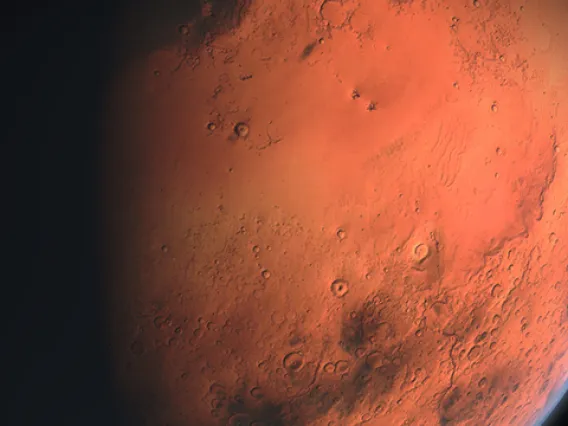
UA Trains Visually Impaired Youth for STEM
By La Monica EverettUA Trains Visually Impaired Youth for STEM
×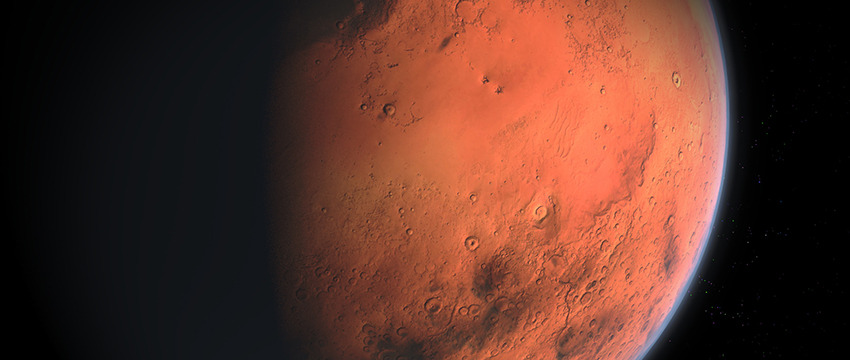
By La Monica Everett-Haynes, University Communications - July 5, 2017
Using images and data from the University of Arizona's Mars HiRISE camera, Sunggye Hong and Stephen Kortenkamp are creating educational experiences and tactile tools about the Red Planet to help students gain insight and interest in scientific exploration and study — and motivate students to imagine their future as scientists.
Their interdisciplinary work at the UA has gained the attention of the National Science Foundation, which has provided a grant at more than $1 million to fund a research and engagement project.
"Opening up STEM careers through better awareness among pre-college-age students is a real need," said UA President Robert C. Robbins. "I very much admire that UA faculty in the College of Education are helping create this awareness for students with visual impairments through their engaging approach to learning. This project and the NSF's support for it are outstanding examples of what the UA can do for students through collaboration and the creativity of our faculty members."
Called Project POEM, short for Project-Based Learning Opportunities and Exploration of Mentorship for Students With Visual Impairments in STEM, the effort will involve 35 middle and high school students with visual impairments in a 14-month program meant to train them toward the science, technology, engineering and mathematics fields.
"Mars is one of the most fascinating topics in the world of science today. If a student has an opportunity to study and to analyze data collected from Mars, that would be a very exciting and motivational component to helping students' interest in science," said Hong, associate professor in the UA College of Education's Department of Disability and Psychoeducational Studies and principal investigator on the NSF grant.
Other Project POEM collaborators are the UA Sky School, the UA Department of Mining and Geological Engineering, the UCAR Center for Science Education, the American Printing House for the Blind and Denver-based educational consultant McREL International.
In developing the program, Hong and his partners were attentive and responsive to the Next Generation Science Standards, a multistate effort developed by a team of researchers commissioned by the Carnegie Foundation.
Mentors to Lend Support
As such, the program will be project-based, rich in content and complemented by the support of mentors — UA undergraduate and graduate students and also STEM industry professionals who have visual impairments.
The educational tools being designed also address the problem of students with visual impairments having too little access to the types of resources that can help them understand complex scientific topics and drive their interests in science.
"Much of the STEM curricula is so visual, so you must make appropriate adaptations and modifications for the materials to be used," Hong said.
"We know that there are these difficulties, but there are also techniques we can use to navigate such barriers," he said. "If students are frustrated with not having properly modified materials, they can talk through problems with people who have gone through the same frustrations, and students with visual impairments can figure out ways to overcome those difficulties."
Using images and data from Mars sourced by the UA's Lunar and Planetary Laboratory, the team led by Hong is also creating tactile, 3-D models of the surface of Mars that students can use to study the planet's physical characteristics.
Over the course of the program, the middle and high school students will learn about STEM concepts and Mars through learning models and other forms of engagement. They then will work alongside their mentors to develop and execute a research project about Mars, relying on adapted images and also data from the UA's HiRISE camera currently operating on the Mars Reconnaissance Orbiter.
The project draws heavily on the child education expertise of Kortenkamp, associate professor of practice in the Lunar and Planetary Laboratory in the College of Science, who also written and published children's books on topical issues related to science.
Kortenkamp also said he is especially dedicated to improving resources for students with visual impairments after having worked early in his UA career with a student who was blind.
"Astronomy is such a visual field, so it became a challenge for me in how I was teaching the course," Kortenkamp said. He began to more readily employ audio components and also introduced tactile tools — resources he would use for years.
"Finding other ways of presenting the material, rather than just lecturing, is so fascinating. And putting that extra effort of finding materials and presenting them — whether your student can see them or not — helps to show that you are truly invested in learning," Kortenkamp said.
Also motivating Hong and Kortenkamp is the need for improved STEM-related educational resources and the problem of underemployment among individuals with disabilities, especially in STEM fields.
Creating a 'Set of Experiences'
Individuals with visual impairments are highly underemployed, with the U.S. Census Bureau and the American Foundation for the Blind reporting that only 30 to 38 percent of that adult population is employed.
"When you see 70 percent of a population unemployed, that is a huge problem," Hong said. "Our idea was that if we could create a set of experiences for students with visual impairments to give them knowledge about STEM fields and find ways to keep them motivated in considering the STEM field as a potential occupation, we could raise their persistence toward STEM."
Ultimately, the team plans to develop curricula that K-12 teachers may use to replicate the program in other parts of Arizona and the nation.
"Students with visual impairments are capable of becoming successful scientists — if all the pieces of the puzzle are given appropriately," Hong said. "It is not the limitation of an individual, it is more about awareness of the public and working to bring STEM experiences to people with visual impairments."
Also, a research initiative is embedded within the project, and the team will be evaluating best approaches and methods for designing the effective and immersive experience to actively engage students.
"Not everyone will become a scientist. But if they can gain interest in these technical areas, they may take a different route in life or have a deeper appreciation for the field and become more technologically savvy," Kortenkamp said. "It never hurts to have some of that background, or at least be comfortable around science and math."

UA Scientists and the Curious Case of the Warped Kuiper Belt
By Daniel StolteUA Scientists and the Curious Case of the Warped Kuiper Belt
×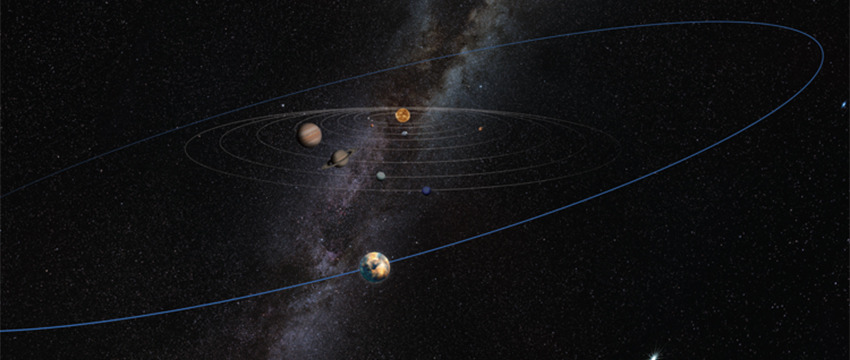
By Daniel Stolte, University Communications - June 20, 2017
An unknown, unseen "planetary mass object" may lurk in the outer reaches of our solar system, according to new research on the orbits of minor planets to be published in the Astronomical Journal. This object would be different from — and much closer than — the so-called Planet Nine, a planet whose existence yet awaits confirmation.
In the paper, Kat Volk and Renu Malhotra of the University of Arizona's Lunar and Planetary Laboratory, or LPL, present compelling evidence of a yet-to-be- discovered planetary body with a mass somewhere between that of Mars and Earth. The mysterious mass, the authors show, has given away its presence — for now — only by controlling the orbital planes of a population of space rocks known as Kuiper Belt objects, or KBOs, in the icy outskirts of the solar system.
While most KBOs — debris left over from the formation of the solar system — orbit the sun with orbital tilts (inclinations) that average out to what planetary scientists call the invariable plane of the solar system, the most distant of the Kuiper Belt's objects do not. Their average plane, Volk and Malhotra discovered, is tilted away from the invariable plane by about eight degrees. In other words, something unknown is warping the average orbital plane of the outer solar system.
"The most likely explanation for our results is that there is some unseen mass," says Volk, a postdoctoral fellow at LPL and the lead author of the study. "According to our calculations, something as massive as Mars would be needed to cause the warp that we measured."
The Kuiper Belt lies beyond the orbit of Neptune and extends to a few hundred Astronomical Units, or AU, with one AU representing the distance between Earth and the sun. Like its inner solar system cousin, the asteroid belt between Mars and Jupiter, the Kuiper Belt hosts a vast number of minor planets, mostly small icy bodies (the precursors of comets), and a few dwarf planets.
For the study, Volk and Malhotra analyzed the tilt angles of the orbital planes of more than 600 objects in the Kuiper Belt in order to determine the common direction about which these orbital planes all precess. Precession refers to the slow change or "wobble" in the orientation of a rotating object.
KBOs operate in an analogous way to spinning tops, explains Malhotra, who is a Louise Foucar Marshall Science Research Professor and Regents' Professor of Planetary Sciences at LPL.
"Imagine you have lots and lots of fast-spinning tops, and you give each one a slight nudge," she says. "If you then take a snapshot of them, you will find that their spin axes will be at different orientations, but on average, they will be pointing to the local gravitational field of Earth.
"We expect each of the KBOs' orbital tilt angle to be at a different orientation, but on average, they will be pointing perpendicular to the plane determined by the sun and the big planets."
If one were to think of the average orbital plane of objects in the outer solar system as a sheet, it should be quite flat past 50 AU, according to Volk.
"But going further out from 50 to 80 AU, we found that the average plane actually warps away from the invariable plane," she explains. "There is a range of uncertainties for the measured warp, but there is not more than 1 or 2 percent chance that this warp is merely a statistical fluke of the limited observational sample of KBOs."
In other words, the effect is most likely a real signal rather than a statistical fluke. According to the calculations, an object with the mass of Mars orbiting roughly 60 AU from the sun on an orbit tilted by about eight degrees (to the average plane of the known planets) has sufficient gravitational influence to warp the orbital plane of the distant KBOs within about 10 AU to either side.
"The observed distant KBOs are concentrated in a ring about 30 AU wide and would feel the gravity of such a planetary mass object over time," Volk said, "so hypothesizing one planetary mass to cause the observed warp is not unreasonable across that distance."
This rules out the possibility that the postulated object in this case could be the hypothetical Planet Nine, whose existence has been suggested based on other observations. That planet is predicted to be much more massive (about 10 Earth masses) and much farther out at 500 to 700 AU.
"That is too far away to influence these KBOs," Volk said. "It certainly has to be much closer than 100 AU to substantially affect the KBOs in that range."
Because a planet, by definition, has to have cleared its orbit of minor planets such as KBOs, the authors refer to the hypothetical mass as a planetary mass object. The data also do not rule out the possibility that the warp could result from more than one planetary mass object.
So why haven't we found it yet? Most likely, according to Malhotra and Volk, because we haven't yet searched the entire sky for distant solar system objects. The most likely place a planetary mass object could be hiding would be in the galactic plane, an area so densely packed with stars that solar system surveys tend to avoid it.
"The chance that we have not found such an object of the right brightness and distance simply because of the limitations of the surveys is estimated to be to about 30 percent," Volk said.
A possible alternative to an unseen object that could have ruffled the plane of outer Kuiper Belt objects could be a star that buzzed the solar system in recent (by astronomical standards) history, the authors said.
"A passing star would draw all the 'spinning tops' in one direction," Malhotra said. “Once the star is gone, all the KBOs will go back to precessing around their previous plane. That would have required an extremely close passage at about 100 AU, and the warp would be erased within 10 million years, so we don't consider this a likely scenario."
Humankind's chance to catch a glimpse of the mysterious object might come fairly soon once construction of the Large Synoptic Survey Telescope is completed. Run by a consortium that includes the UA and scheduled for first light in 2020, the instrument will take unprecedented, real-time surveys of the sky, night after night.
"We expect LSST to bring the number of observed KBOs from currently about 2000 to 40,000," Malhotra said. "There are a lot more KBOs out there — we just have not seen them yet. Some of them are too far and dim even for LSST to spot, but because the telescope will cover the sky much more comprehensively than current surveys, it should be able to detect this object, if it's out there."
UA to Host Special Events Tied to Asteroid Day
UniversityUA to Host Special Events Tied to Asteroid Day
×University Communications - June 13, 2017
A presentation at the University of Arizona on June 27 will feature six experts exploring the most up-to-date asteroid science.
Moderated by television host Geoff Notkin from the show "Meteorite Men," the event will bring together five researchers from the UA who work at the forefront of asteroid science. The presentation at the Flandrau Science Center & Planetarium is free and open to the public. Seating is limited and admittance is first-come, first-served.
Expert presenters scheduled to participate include:
- Dante Lauretta, principal investigator for NASA's OSIRIS-REx mission and professor at the UA Lunar and Planetary Laboratory
- Eric Christensen, director of the Catalina Sky Survey for Near-Earth Objects and associate staff scientist at the Lunar and Planetary Laboratory
- Heather Enos, deputy principal investigator for the OSIRIS-REx mission
- Vishnu Reddy, assistant professor at the Lunar and Planetary Laboratory
- Geoff Notkin, Board of Governors, National Space Society
- Daniella DellaGiustina, image processing lead for the OSIRIS-REx mission
The presentation will be recorded for broadcast as part of a special 24-hour Asteroid Day Live broadcast organized by the nation of Luxembourg. Flandrau Science Center will offer this live broadcast as part of its exhibits during business hours on Asteroid Day, which is June 30.
On Asteroid Day and through the weekend that follows, Flandrau Science Center & Planetarium will recognize Asteroid Day/Weekend with special activities related to asteroids and the OSIRIS-REx mission, asteroid planetarium shows, and asteroid exhibits for the public. More information is available at www.flandrau.org.
To raise awareness of asteroids and the important role they have played in the evolution of the solar system and throughout Earth's history, June 30 is designated annually as Asteroid Day. The date commemorates Earth's largest asteroid impact in recorded history, the Siberia Tunguska event, which leveled trees across 770 square miles, more than three times the area of Tucson, in 1908.
Currently, the UA leads the OSIRIS-REx mission, an $800 million NASA mission that will bring back a sample from the asteroid Bennu. The UA also has the most internationally active program to identify and track Near-Earth Objects, or NEOs. More than half of all known near-Earth asteroids and comets have been discovered by the UA.

Amazonia's Future Will Be Jeopardized by Dams
By Mari N. JensenAmazonia's Future Will Be Jeopardized by Dams
×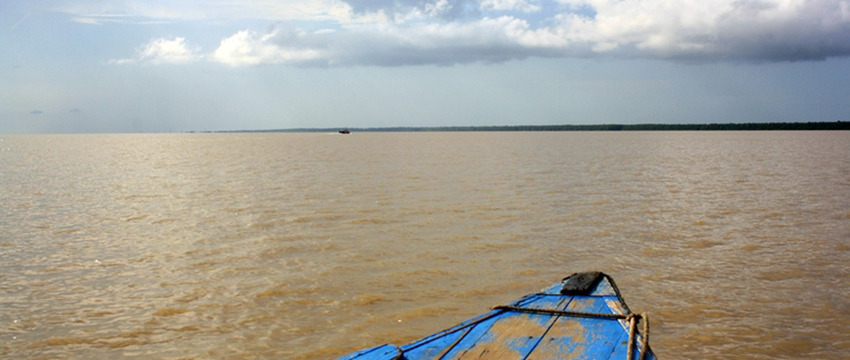
By Mari N. Jensen, UA College of Science, and Rachel Griess, University of Texas, Austin - June 14, 2017
Building the hundreds of hydroelectric dams proposed for the Amazon River Basin will cause massive environmental damage all the way from the eastern slopes of the Andes to the Atlantic Ocean, according to new findings by an international team of researchers that includes a University of Arizona hydrologist.
The Amazon River and its watershed — the largest river system on Earth — cover 6.1 million square kilometers (2.4 million square miles) and include nine countries.
"The Amazon is the most important river basin on the planet. It’s a microcosm of our issues of today involving environment, energy and health of the planet," said co-author Victor R. Baker, University of Arizona Regents' Professor of Hydrology and Atmospheric Sciences.
The 428 current and proposed dams will have environmental impact throughout the entire system, the team reports in the June 15 issue of the journal Nature. About one-third of the 428 dams are built or are under construction.
While these hydroelectric dams have been justified for providing renewable energy and avoiding carbon emissions, little attention has been paid to the major disturbances dams present to the Amazon floodplains, rainforests, the northeast coast of South America and the regional climate, the researchers write.
Generally, only the local environmental impact of a dam is considered, not the regional or systemwide effect.
"The river and its individual pieces cannot be separated out. That an individual dam assessment can be separated from the rest of the system isn't scientifically valid,” said Baker, who is also a UA professor of planetary sciences and of geosciences.
The research team conducted a large-scale assessment of how the current and future dams will affect the entire Amazon Basin. The researchers developed a Dam Environmental Vulnerability Index to quantify their assessment. The DEVI ranges from one to 100, with 100 being the most vulnerable.
The DEVI incorporates overall changes to the river systems from dams, including the potential land use changes, erosion, runoff, changes in sediment deposition, the effects on the region's rich biodiversity and impact to the regional food supply.
The researchers found the watershed of the Madeira River, the largest Amazon tributary, will sustain the greatest negative impact from the current and future dams. The team assigned that region a DEVI above 80.
Lead author Edgardo Latrubesse, a geography and the environment professor at the University of Texas, Austin, said, "The impacts can be not only regional, but also on an interhemispheric scale. If all the planned dams in the basin are constructed, their cumulative effect will trigger a change in sediment flowing into the Atlantic Ocean that may hinder the regional climate."
The paper by Latrubesse, Baker and their 14 colleagues is titled, "Damming the Rivers of the Amazon Basin." The National Science Foundation, NASA, the National Geographic Society, LLILAS-Mellon, the Brazilian Council for Scientific and Technological Development-CNPq and CAPES Foundation funded the research.
Rivers in the Amazon Basin move like a dance, exchanging sediments across continental distances to deliver nutrients to a mosaic of wetlands, Latrubesse said.
Sediment transported by rivers provides nutrients that sustain wildlife, contribute to the regional food supplies and modulate river dynamics that result in high habitat and biotic diversity for both aquatic and nonaquatic organisms.
Many current and proposed dams are located far upstream in the Andean region. Research indicates that the Andes provide more than 90 percent of the sediment to the entire Amazon Basin. Dams trap the nutrient-rich sediment and prevent it from moving downstream.
The Madeira River is home to the most diverse fish population in the Amazon. Since the huge Santo Antônio and Jiaru dams were constructed on the Madeira, the river's average sediment concentration decreased by 20 percent. Researchers expect the 25 dams planned for further upstream will trap additional nutrient-rich sediment behind them.
The largest preserved mangrove region of South America is along the coastline of northeast Brazil and the three Guianas and needs sediment from the Amazon, Latrubesse said.
Baker added that the cumulative impact from the dams affects rainfall and storm patterns from the Amazon Basin to the Gulf of Mexico. In addition to changes in sediment flow, the impact includes the storage of water behind the dams, the water flows and the timing of flows to the mouth of the river.
The study's authors conclude: "Citizens of the Amazon Basin countries will ultimately have to decide whether hydropower generation is worth the price of causing profound damage to the most diverse and productive river system in the world. If those decisions are made within the context of a comprehensive understanding of the fluvial system as a whole, the many benefits the rivers provide to humans and the environment could be retained."
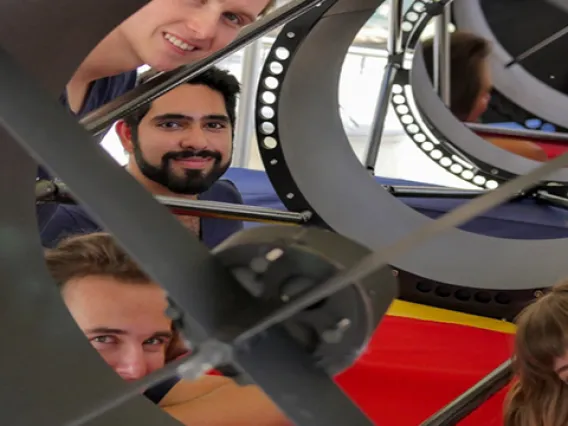
Students Build Telescopes to Track Satellites
By Emily Litvack, UA
Students Build Telescopes to Track Satellites
×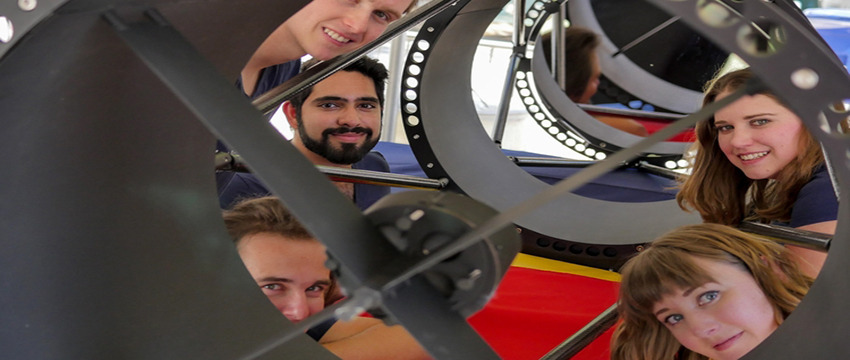
By Emily Litvack, UA Research, Dicovery and Innovation - May 22, 2017
Why should you buy what you can make for yourself?
That's the principle that drove five undergraduate students from the University of Arizona's College of Engineering, led by assistant professor Vishnu Reddy of the Lunar and Planetary Laboratory, to build two telescopes from the ground up to track satellites and space junk.
Reddy joined the UA faculty eight months ago, offering expertise in space situational awareness. A large part of SSA involves tracking satellites and space junk around Earth. Federal entities such as the U.S. Department of Defense do so on a regular basis. It's work that requires a large amount of observing time on small telescopes.
While the UA runs more than 20 large telescopes across the globe, few of them are suited for tracking satellites. Having a telescope on campus provides an easy opportunity for student access without a trip to Kitt Peak or Mount Lemmon.
Reddy identified the perfect — and conveniently vacant — space for a small telescope. In the 1990s, a room on the sixth floor of the Kuiper Space Sciences Building was transformed into a small observatory, complete with a retractable roof, so that Bob McMillan, Reddy's colleague in the Lunar and Planetary Lab, could observe stars. The room was last used for observation in 1995, later becoming a storage facility.
Instead of buying the telescopes off the shelf for upward of $50,000 apiece, Reddy recruited five undergraduate engineers to build them through the Engineering Design Program. The program, aimed at preparing the students for careers in engineering, requires all engineering students at the UA to spend their senior year designing, building and testing technologies in teams of four to six, culminating in an annual Engineering Design Day, which this year was held on May 1.
Reddy's team included Lindsie Jeffries, senior in biomedical engineering and mathematics; Sameep Arora, senior in mechanical engineering; Ryan Bronson, senior in optical sciences and mathematics; Damon Marco Colpo, senior in optical sciences and mathematics; and Evelyn Hunten, senior in electrical and computer engineering.
Asked if anything about the project surprised him, Reddy responded unequivocally.
"(It's) the students," he said. "Undergrads are some of the most optimistic people on campus. They're full of life, they feel positive about the future, and they inspire me to be enthusiastic."
Hunten, who landed a post-graduation position at IBM, said she loves space science and exploration.
"This project was the one I wanted to work on," she said. "It was my first choice. I love the instrumentation behind scientific discoveries."
Together, the students built two 24-inch telescopes in seven months for $30,000 total. The mirrors they installed in the new telescopes were recycled from the telescope in the old Kuiper observatory. Written off as junk, the mirrors were headed for the UA's Surplus Store.
A local astronomy business, Starizona, was instrumental in training the students and testing the telescopes' optics, Reddy said.
Starting June 20, after a first light ceremony at 6 p.m., one of the telescopes will run autonomously each night in the place where the old one once stood. It's the first time that a telescope has been installed on campus since the 1990s. The location for the second telescope has yet to be determined, but Biosphere 2 has been discussed as a possibility.
Arora, who designed the telescope model in SolidWorks, a design program, said that making "an actual product that will be used for science" — rather than a prototype — was a rewarding experience.
Jeffries, who will pursue a graduate degree in biomechanical engineering at Stanford University, said, "It was exciting putting the telescope together and confirming that everything fit and worked. I also enjoyed getting to know my teammates. They were all hard workers who cared about the project and pushed me to do my best."
While the team was building the telescopes, Reddy was writing a proposal to the Air Force Research Laboratory, requesting funding for a spectroscopic survey of satellites in the geostationary orbit. Satellites in geostationary orbit revolve around Earth at the same rate that Earth rotates on its axis. This makes them hover above the same location on Earth.
Because their rotation matches ours — moving from west to east — they appear as fixed in space when we look at them from telescopes on Earth. More than 500 such satellites are in orbit today.
Rather than tracking satellites as mere nondescript dots in space — which is not uncommon — Reddy will be able to use the telescopes to identify some unique color signatures of satellites, to find out exactly which one is which.
"The UA is going to be a leader in space situational awareness, and we really want to capitalize on our exceptional undergraduate students," Reddy said. "This is also workforce development. We need an American workforce that can rise to the challenges of our national security needs, and the needs of our nation."
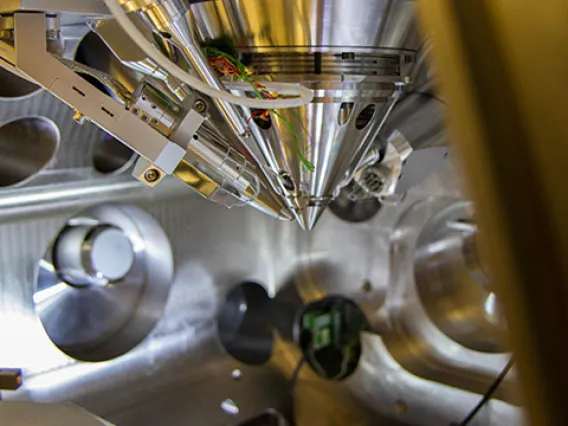
So You Want to Analyze Asteroid Dirt
By Emily Litvack -
So You Want to Analyze Asteroid Dirt
×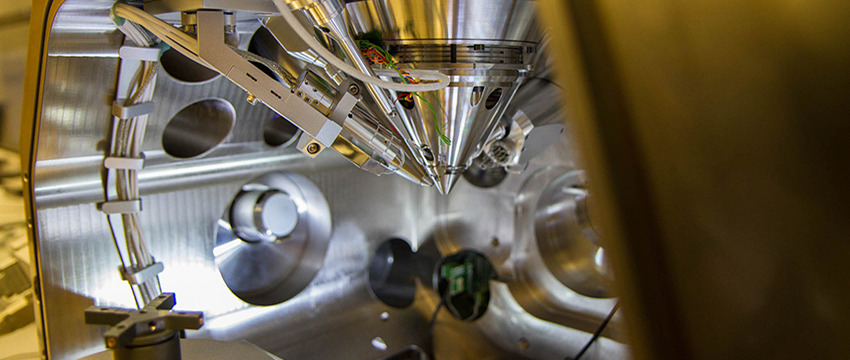
By Emily Litvack - May 18, 2017
In the year 2023, priceless property of the American people will land somewhere in the Utah desert. And when it does, a team of engineers and scientists will be waiting on the ground. Thousands will watch with eyes glued to smart phones and televisions. Headlines around the world will tell of its journey.
The priceless property is 2 to 70 ounces of asteroid dirt.
This 4.5-billion-year-old dirt, formally known as “regolith,” will look like a small pile of dusty rubble, gleaned in the five-second moment during which NASA’s OSIRIS-REx spacecraft vacuumed the surface of a carbon-rich, near-Earth asteroid called Bennu.
Landing, encapsulated, at the Utah Test and Training Range on the planet Earth will begin a new phase in its existence in the universe: analysis. After being transported to the Johnson Space Center in Houston, the dirt will be removed from its capsule, and then allocated to scientists for study.
OSIRIS-REx is the United States’ first mission to return an asteroid sample to Earth, but for scientists like Tom Zega, return to Earth is just the beginning. Zega is a sample scientist at the University of Arizona. As a collaborator on the OSIRIS-REx mission, led by NASA and the UA, he will be one of the first scientists to analyze regolith from Bennu.
Why Return Samples?
One of the main goals of the OSIRIS-REx mission, he says, is understanding the earliest history of our solar system, and the origins of life. Regolith from an asteroid might be our best shot at this.
“Sample return is great because otherwise you’re at the mercy of what falls from the sky,” says Zega. Simply, you get what you get. The regolith from Bennu will be untouched. Uncontaminated by our atmosphere. Pristine. “Sample return is a treasure trove of information.”
“You’re getting samples that are older than Earth. I can literally hold in my hand a piece of the origins of our solar system that predated Earth, predated human beings, predated everything we know,” says Zega. “These are atoms that assembled four and a half billion years ago and became the building blocks of our planet.”
The only question left is what to do with such a scientifically valuable pile of dirt.
Building a Lab Fit for Analysis
“Analysis” can mean many things. In the case of using asteroid regolith to understand the origins of the solar system, analysis means two things, both of which require large equipment in a stable environment. The first: high-resolution imaging. The second: measuring chemistry. Respectively, answering the questions “What does it look like?” and “What is it made of?”
“We’re sort of like forensic scientists,” says Zega. “Nature grew these materials, and we’re analyzing it at a fundamental level to figure out under what conditions.”
Zega does this in the 5,000-square-foot basement of the Kuiper Space Sciences building, constructed at the UA in 1964 with funds from NASA. The basement was once a mirror lab for telescopes and a publications vault. Telescopes got bigger, and so did the mirror lab. It now lives under UA’s Arizona Stadium. Publications went online. Now, the UA’s collection of high-tech electron microscopes—to be used for studying the returned asteroid dirt—live here.
Sensitive to stimulus, electron microscopes need a place with minimal vibrations, minimal electromagnetic interference, and good acoustics. As it turns out, explains Zega as he stands outside the two frosted doors of the lab, basements make good spots for these kinds of microscopes. As of today, the lab is “ready to hit the ground running” when the asteroid sample from OSIRIS-REx shows up.
In fact, the lab is in the process of studying a sample from Hayabusa 1, an asteroid sample return mission by JAXA, the Japanese equivalent of NASA. Like OSIRIS-REx, Hayabusa 2 is now cruising towards its target, the asteroid Ryugu.
He opens the doors, revealing a long, clean, fluorescent-lit corridor.
Analyzing the Sample
At the end of the corridor, in a room on the left, is where the asteroid sample’s time in the lab will truly begin. After it’s mounted on a glass slide and polished smooth, Zega will place the sample in an electron microprobe.
“The microprobe gives us the most context, and a lay of the land,” says Zega. It allows him to photograph the entire sample in high-resolution, and map out its chemistry, element by element. Those elements, like iron and nickel and magnesium, show up as colors on a computer screen.
“You want to sit down and really process that data. You might want to play around with the maps and overlay them onto the high-res images that you also created before you decide what the next step is. That can take some time,” says Zega. “You really want to take your time here before going onto a more detailed level of analysis.”
Then, all the way at the other end of the corridor, near the doorway, there are two scanning electron microscopes. Like the microprobe, they too image and chemically map the sample, but at an even more detailed level. Here, Zega can look at the dirt in micrometers and nanometers—a billionth of a meter. A single sheet of paper is about 100,000 nanometers thick.
In the room next door, a focused-ion-beam scanning-electron microscope can look at the sample in even greater detail. It can also drill a hole in a piece of dust from the asteroid by shooting gallium ions at it, like teeny-tiny bullets.
“Every atom has something to tell us,” says Zega, walking toward the final destination for the asteroid sample: the transmission electron microscope, or TEM. It’s a towering box of off-white and blue, about 12-feet-tall. There’s an innate humor in its largeness, because a TEM is the only machine in the world that can see something as tiny as an individual atom. The TEM, purchased from Hitachi High Technologies in 2016, was shipped by boat from Japan months earlier. A team of engineers from the company’s headquarters outside of Tokyo have been here since November, installing and calibrating the microscope. They are expected to head home in June.
“Looking at microstructures is useful for figuring out origins,” explains Zega. Which atoms of an element are next to, or layered on top of, which other atoms is critically important when you want to figure out how something formed.
Looking to the Stars for Answers
In the best case scenario, analyzing the asteroid dirt means “we rewrite the textbooks on our understanding of the origins of our solar system,” says Zega. “I think that’s the neatest thing about a mission like this. It can be full of surprises.”
“Scientist or not, we all look to the stars and ask ‘How?’ and ‘Why?’ We wonder how it all came to be,” says Zega. “The work that we do here at the University of Arizona contributes to answering those questions.”
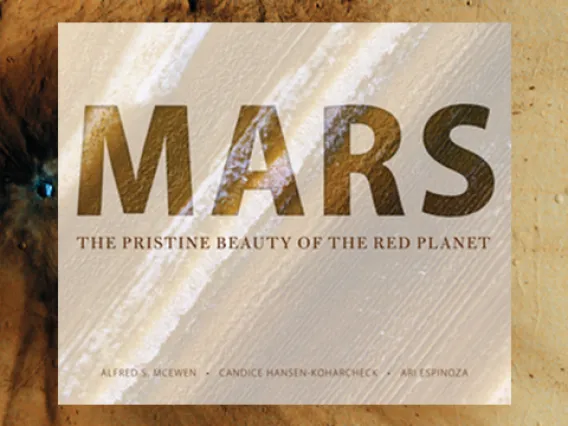
HiRISE Brings the Red Planet's Beauty to Your Coffee Table
By Daniel Stolte
HiRISE Brings the Red Planet's Beauty to Your Coffee Table
×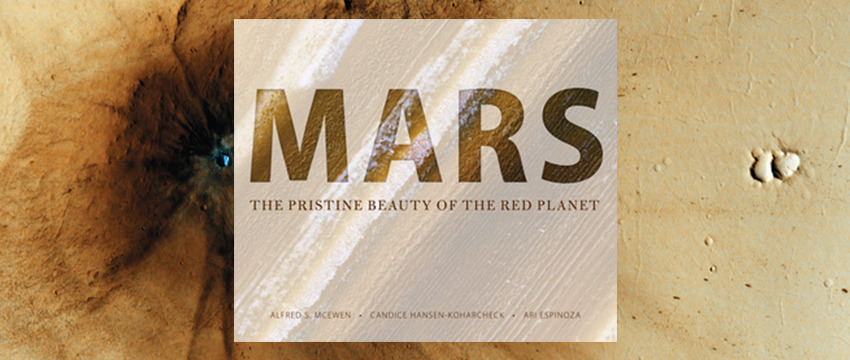
By Daniel Stolte, University Communications - May 15, 2017
A gorgeous, sumptuous tome chock-full of stunning images taken by the most powerful camera ever sent to another planet now brings Mars to armchair explorers on Earth.
Weighing in at nearly eight pounds, "Mars: The Pristine Beauty of the Red Planet" features close to 200 carefully selected photographs taken by the University of Arizona-led HiRISE camera, which has been orbiting Mars on NASA's Mars Reconnaissance Orbiter since 2006.
Arranged into chapters that guide the reader/viewer from familiar features such as sand dunes to more alien landscapes one cannot glimpse on our own planet, the photos and accompanying captions amount to 425 pages compiled by UA HiRISE scientists. Published by UA Press, the book is available at bookstores and online.
In a sense, the volume represents a "best of" from the treasure trove of high-resolution images snapped by the HiRISE camera for more than a decade. Orbiting Mars anywhere from 125 to 186 miles above the surface, the HiRISE camera has revealed a Red Planet that is anything but dead — at least in geological and climatic terms.
"Throughout the lifetime of this mission, I had been saving favorite images that I thought were interesting," says Alfred McEwen, principal investigator of the HiRISE project and one of the book's authors. "We encouraged our roughly 50 team members who work with the images coming down from the spacecraft to submit their favorites to the project."
Ari Espinoza, outreach coordinator for HiRISE and a co-author of the book, recalls how the project started.
"Through our 'Beautiful Mars' project, volunteers around the world had already translated some of the image captions into 24 other languages," he says, "and with that in mind, I wrote the book proposal and pitched it to UA Press. Fortunately for us, the editorial board was excited about the project."
The result is a visual journey across the surface of Mars. With artistic glimpses at actively eroding slopes, impact craters, strange polar landscapes, avalanches and even spectacular pictures capturing the Phoenix Lander and the Curiosity Rover descending on their parachutes, the reader gets to see what researchers are seeing.
"The really difficult part was to cull the photo material down to a couple of hundred," McEwen says.
Co-author Candice Hansen-Koharcheck, senior scientist at the Planetary Science Institute and deputy principal investigator of HiRISE, adds: "In the end, there were many hard decisions to make when we saw how many images hadn't made the cut. There were so many we looked at and realized, 'No, this has to go back in.'"
In the spirit of "the people's camera at Mars," all images beamed back to Earth are published on the HiRISE website, but for the book, the authors optimized each image to bring out the best possible detail or highlight the most interesting features. Because the captions had been written by members of the entire team, McEwen and Hansen-Koharcheck rewrote each of them to ensure they read with one voice.
"Even though we had a big head start with a huge pool of pictures and their initial captions, putting this together for a dedicated book format still required a lot of work," Hansen-Koharcheck says, explaining that the material is presented in a way that resembles what geologists call stratigraphy: an assembly of rock layers deposited over time.
"Except that in the book, we go from top to bottom, or youngest to oldest, which is the opposite of how a geologist would normally do it," Hansen-Koharcheck says. "We realized that because our images have so much detail, you almost have to train people how to look at them."
And so, the visual journey of the Red Planet begins "with the features that are the most obvious and ubiquitous when you first look at the Martian surface — the sand dunes," Hansen-Koharcheck explains. "Then, we explore more recent features like fresh impact craters, all the way to the bedrock at the bottom of ancient craters. But you can't start there, it's just too foreign."
McEwen says the book covers just a sampling, a small selection of Mars' surface, by necessity.
"Mars has so many different landforms, so much diversity, that we can include just a sampling in this publication," he says. "Everything you see here is at HiRISE scale, so if you zoomed out, you could see large, iconic features like Olympus Mons, for example, but here all we see is a small detail of the volcano."
Since HiRISE began collecting data in 2006, the camera has acquired more than 50,000 images, each one a giant, gigapixel-size file. To date, HiRISE has covered just 2.83 percent of the Martian surface, and that is by design, according to McEwen.
"The goal of HiRISE was never to make an exhaustive survey of Mars," he says. "We are looking at such high resolution that this simply would not be possible. HiRISE was designed to focus on identifying the best landing sites and the most scientifically interesting locations."
Instead of systematically mapping Mars, the HiRISE scientists put time and effort on very specific targets.
"We study the Red Planet at a geologist's scale," McEwen says, "and we follow up with previously imaged sites, too. We are learning about the forces that shape Mars as we go, we are documenting what changes are happening today, and we try to gather clues as to what ancient Mars looked like by studying bedrock composition and structures."
Each day, the HiRISE camera makes 13 trips around Mars, and it is scheduled to continue to do so for the foreseeable future.
"Every day at the HiRISE operations center here at the UA, we send the commands to the spacecraft, and we process the data and interpret the images," McEwen says.

Alumni Achievement Award for Dante Lauretta
By UA Alumni
Alumni Achievement Award for Dante Lauretta
×
By UA Alumni Association - May 9, 2017
Dante Lauretta, leader of the University of Arizona's biggest space mission, will receive the institution's Alumni Achievement Award.
Lauretta, a UA professor of planetary science and cosmochemistry and principal investigator of the OSIRIS-REx asteroid sample return mission, has reached the pinnacle of his field, and through his work the UA will remain at the forefront of space exploration for years to come.
Lauretta will receive the award during the University's Commencement ceremony on May 12. He also will be honored as the College of Humanities Alumnus of the Year during an event to be held Oct. 27.
The Alumni Achievement Award is the highest honor the UA Alumni Association can bestow on graduates of the University. It is given to an alumnus or alumna who has attained prominence in his or her field of endeavor and demonstrated outstanding service to the UA.
"I am honored to receive the UA Alumni Achievement Award," Lauretta said. "The University of Arizona has been an essential part of my career from my undergraduate days through my faculty appointment. I am proud to have studied here and to now be contributing to the UA's important education mission."
Lauretta is an expert in the analysis of extraterrestrial materials such as lunar samples, meteorites and comet particles. His work contributes to our understanding of the chemistry of the early solar system and the origin of complex molecules that may have led to life on Earth.
Lauretta is credited with more than 70 peer-reviewed publications and led or participated in more than 20 NASA grants and missions — all while teaching undergraduate and graduate students, giving scholarly presentations, participating in conferences, and serving on departmental, University and extramural committees.
The list of awards and honors Lauretta has received is long and varied. He has an asteroid named in his honor; he was named a Kavli Fellow of the National Academy of Sciences in 2008 and Innovator of the Year by the Arizona governor in 2011; and Good Housekeeping magazine named his Xtronaut game the Best Family Board Game of 2016.
On Sept. 8, 2016, Lauretta earned a spot in history for himself and the UA when the OSIRIS-REx spacecraft successfully launched on a seven-year journey to rendezvous with the asteroid Bennu and return a sample of its material.
As important as the OSIRIS-REx mission is to furthering our understanding of the early solar system, under Lauretta's leadership it also aims to further public engagement in science. The mission's website, asteroidmission.org, features entertaining and engaging videos about planetary science, and mission staff appear as guest speakers at local conventions and in classrooms.
Lauretta also has hosted a regular OSIRIS-REx Science Club at the Tucson Boys and Girls Club.
In 1993, Lauretta earned a Bachelor of Arts from the UA College of Humanities Department of East Asian Studies with an emphasis in Japanese, and also a Bachelor of Science in mathematics and physics from the UA College of Science. He went on to earn a Ph.D. in earth and planetary sciences from Washington University in St. Louis in 1997. He returned to the UA in 2001 to join the faculty of the Lunar and Planetary Laboratory.
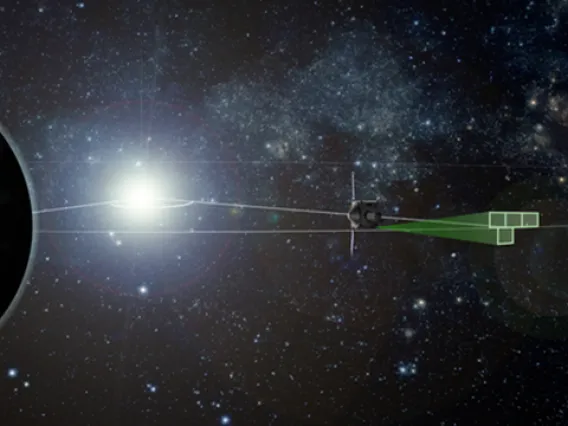
Surveying the Scenery 90 Million Miles From Earth
By Daniel Stolte/UA
Surveying the Scenery 90 Million Miles From Earth
×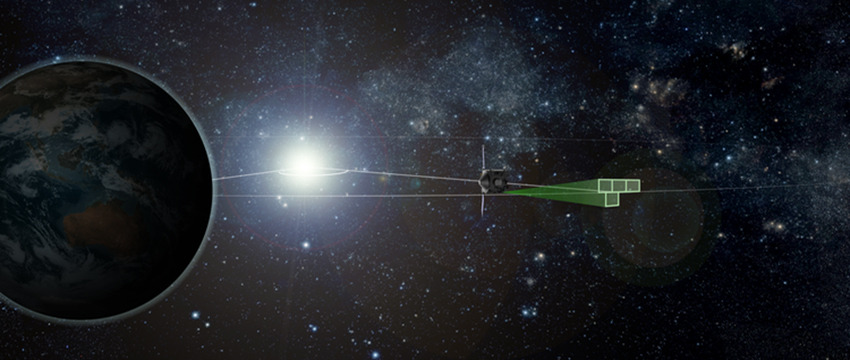
By Daniel Stolte/UA News and Erin Morton/LPL - February 9, 2017
A NASA spacecraft has begun its search for an enigmatic class of near-Earth objects known as Earth-Trojan asteroids. OSIRIS-REx, currently on a two-year outbound journey to the asteroid Bennu, will spend almost two weeks searching for evidence of these small bodies.
Trojan asteroids are trapped in stable gravity wells, called Lagrange points, which precede or follow a planet. OSIRIS-REx is currently traveling through Earth's fourth Lagrange point, which is located 60 degrees ahead in Earth's orbit around the sun, about 90 million miles (150 million kilometers) from our planet. The mission team will use this opportunity to take multiple images of the area with the spacecraft's MapCam camera in the hope of identifying Earth-Trojan asteroids in the region.
MapCam is one of three cameras built at the University of Arizona's Lunar and Planetary Laboratory that will guide the OSIRIS-REx spacecraft to Bennu and document the sampling mission. The search for Earth-Trojans will mark the first time a spacecraft conducts a search for these elusive objects from the L4 point.
The idea for the search originated years ago, shortly after NASA had selected the mission for funding, with Renu Malhotra, a Regents' Professor of Planetary Science at LPL. During a presentation given by Dante Lauretta, now the principal investigator of OSIRIS-REx, Malhotra noticed the spacecraft's trajectory would take it right by Earth's fourth Lagrange point.
"I said to Dante, 'Hey, while you're in that neighborhood of the solar system, you should check out the scenery!'" she says. "I'm thrilled that he and his team were very persistent in making the case to NASA, obtaining approval and making a plan on how to go about the survey."
The search commenced on Feb. 9 and continues through Feb. 20. On each observation day, the spacecraft's MapCam will take 135 survey images that will be processed and examined by the mission's imaging scientists at the UA's Michael J. Drake Building, the mission's headquarters.
Although scientists have discovered thousands of Trojan asteroids accompanying other planets, only one Earth-Trojan has been identified to date, asteroid 2010 TK7. Scientists predict that there should be more Trojans sharing Earth's orbit, but detecting them is extremely difficult, as observers have to point their telescopes to a portion of the sky close to the rising or setting sun. Plus, asteroids are intrinsically faint because they are so small.
"Because the Earth's fourth Lagrange point is relatively stable, it is possible that remnants of the material that built Earth are trapped within it," Lauretta says. "So this search gives us a unique opportunity to explore the primordial building blocks of Earth."
Malhotra echoes Lauretta's excitement: "The search would give us a whole new window on a population of asteroids that we know very little about because we can't see them very well from Earth. We don't know what they might look like — if they are truly primordial material that we don't have in our meteorite collections yet, or whether we might have samples in our collections and simply haven't recognized them as such. If they're out there, it's quite likely they have sent some meteorites to Earth, but we wouldn't know, because we have not been able to connect the dots.
"This is truly an exploration, and there is of course the possibility that we come up empty-handed."
But if it doesn't go that way, scientists will be able to tell us much more about our planet's place in space with regard to what else is out there.
"If there is a sizable population of Trojan bodies where we suspect them to be, it means some might leak out from time to time and possibly hit the Earth or the Moon," Malhotra says. "If we found substantial numbers of these asteroids, it would tell us that Earth's orbit has changed very little over time. Otherwise, it would have been very difficult to retain ancient asteroids in those locations."
Confirming populations of Trojans also might help planetary scientists solve the long-standing "mystery of the missing craters" on the moon, a fascinating side story all by itself.
As the moon travels through space along its orbit around Earth, it gets struck by space rocks crossing its path. Naturally, the hemisphere that is facing forward is being pelted more frequently than the moon's trailing hemisphere, Malhotra explains.
"Just like when you run through the rain, you get more drops on your forehead than on the back side of your head," she says.
But when the researchers calculated what should be the difference in cratering rate on the moon's leading versus its trailing side, they found a discrepancy, showing that the moon gets hit more frequently than it should, based on known asteroid populations.
"One possible explanation is there might be hidden populations of asteroids," Malhotra says, "and the Earth's Trojans could be one of them."
Regardless of whether the OSIRIS-REx team discovers any new asteroids, the search provides a valuable opportunity for a "rehearsal" exercise. The operations involved in searching for Earth-Trojan asteroids closely resemble those required to search for natural satellites and other potential hazards around Bennu when the spacecraft approaches its target in 2018. Being able to practice these mission-critical operations in advance will help the OSIRIS-REx team reduce mission risk once the spacecraft arrives at Bennu.
The study plan also includes opportunities for MapCam to image Jupiter, several galaxies, and the main belt asteroids 55 Pandora, 47 Aglaja and 12 Victoria.
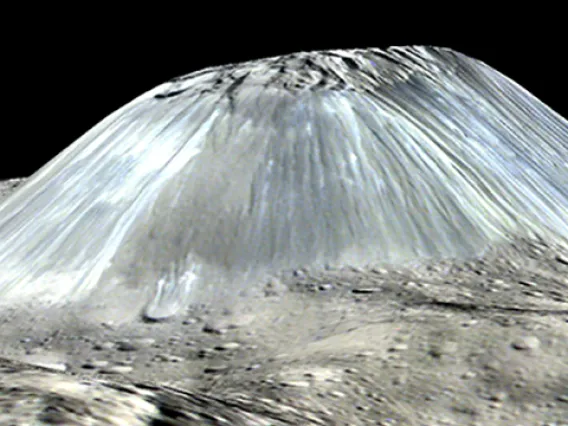
The Mystery of Ahuna Mons, the Lonely Ice Volcano
By American
The Mystery of Ahuna Mons, the Lonely Ice Volcano
×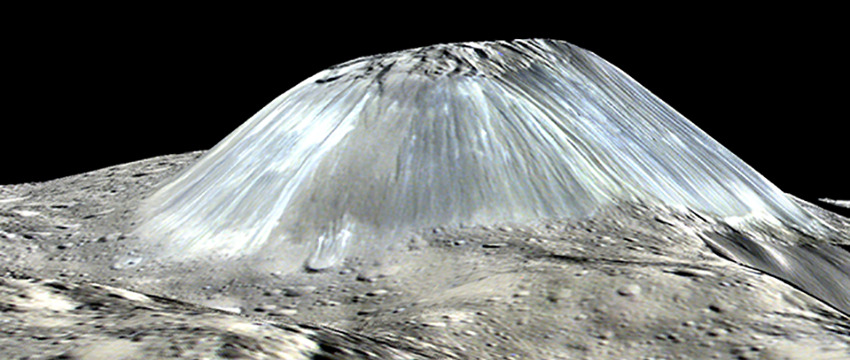
By American Geophysical Union/University Communications - February 2, 2017
A recently discovered solitary ice volcano on the dwarf planet Ceres may have some hidden older siblings, say scientists who have tested a likely way such mountains of icy rock — called cryovolcanoes — might disappear over millions of years.
NASA's Dawn spacecraft discovered Ceres' 4-kilometer-tall (2.5-mile) Ahuna Mons cryovolcano in 2015. Other icy worlds in our solar system, such as Pluto, Europa, Triton, Charon and Titan, also may have cryovolcanoes, but Ahuna Mons is conspicuously alone on Ceres. The dwarf planet, with an orbit between Mars and Jupiter, also lies far closer to the sun than other planetary bodies where cryovolcanoes have been found.
Now scientists show there may have been cryovolcanoes other than Ahuna Mons on Ceres millions or billions of years ago, but these cryovolcanoes may have flattened out over time and become indistinguishable from the planet's surface. They report their findings in a new paper accepted for publication in Geophysical Research Letters, a journal of the American Geophysical Union.
"We think we have a very good case that there have been lots of cryovolcanoes on Ceres but they have deformed," said Michael Sori of the Lunar and Planetary Laboratory at the University of Arizona, the lead author of the new paper. Co-authors on the study include LPL members Shane Byrne, Ali Bramson and Christopher Hamilton.
Ahuna Mons is a prominent feature on Ceres, rising to about half the height of Mount Everest. Its solitary existence has puzzled scientists since they spied it.
"Imagine if there was just one volcano on all of Earth," Sori said. "That would be puzzling."
Adding to the puzzle are the steep sides and well-defined features of Ahuna Mons — usually signs of geologic youth, Sori said. That leads to two possibilities: Ahuna Mons is just as it appears, inexplicably alone after forming relatively recently on an otherwise inactive world. Or, the cryovolcano is not alone or unusual, and there is some process on Ceres that has destroyed its predecessors and left the young Ahuna Mons as the solitary cryovolcano on the dwarf planet, according to Sori.
Ceres has no atmosphere, so the processes that wear down volcanoes on Earth — wind, rain and ice — aren't possible on the dwarf planet. Sori and his colleagues hypothesized that another process, called viscous relaxation, could be at work.
Viscous relaxation is the idea that just about any solid will flow, given enough time. For example, a cold block of honey appears to be solid. But if given enough time, the block will flatten until there is no sign left of the original block structure.
On Earth, viscous relaxation is what makes glaciers flow, Sori explained. The process doesn't affect volcanoes on Earth because they are made of rock, but Ceres' volcanoes contain ice, making viscous relaxation possible. On Ceres, viscous relaxation could be causing older cryovolcanoes to flatten over millions of years so they are hard to discern. Ceres' location close to the sun could make the process more pronounced, Sori said.
To test the idea that viscous relaxation had caused cryovolcanoes to flatten out on Ceres, Sori and his colleagues created a model using the actual dimensions of Ahuna Mons to predict how fast the mountain might be flowing. They ran the model assuming different water contents of the material that makes up the mountain — ranging from 100 percent water ice to 40 percent water ice, Sori explained.
Ahuna Mons would need to be composed of more than 40 percent water ice to be affected by viscous relaxation, they found. At this composition, Sori estimates that Ahuna Mons should be flattening at a rate of 10 to 50 meters (30 to 160 feet) per million years. That is enough to render cryovolcanoes unrecognizable in hundreds of millions to billions of years, suggesting there could have been other cryovolcanoes on Ceres, according to the new study.
"Ahuna Mons is at most 200 million years old. It just hasn't had time to deform," Sori said.
The next step for Sori and his team will be to try to identify the flattened remnants of older cryovolcanoes on Ceres. The findings could help scientists better decipher the history of how the dwarf planet formed, he added.
The new study helps scientists expand their knowledge of what might be possible on planetary bodies in our solar system, said Kelsi Singer, a postdoctoral researcher who studies icy worlds at Southwest Research Institute in Boulder, Colorado, and was not involved with the new research.
"It would be fun to check some of the other features that are potentially older domes on Ceres to see if they fit in with the theory of how the shapes should viscously evolve over time," she said. "Because all of the putative cryovolcanic features on other worlds are different, I think this helps to expand our inventory of what is possible."
